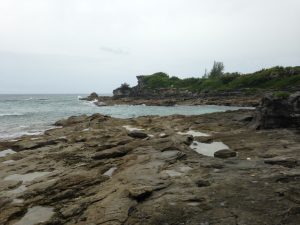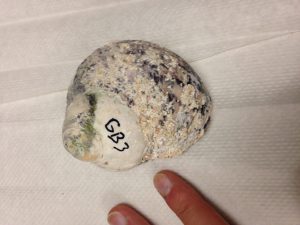8 February 2017
Greenland Ice Sheet melting can cool subtropics and alter climate
Posted by Nanci Bompey
Effects of melting during last interglacial could shed light on current warming
By Lauren Lipuma

The south coast of Bermuda where scientists dug up up fossilized shells of sea snails. Analysis of the shells shows a large pulse of cold freshwater covered the North Atlantic for a brief period of time about 125,000 years ago.
Credit: Ian Winkelstern
A new study finds evidence that the last time Earth was as warm as it is today, cold freshwater from a melting Greenland Ice Sheet circulated in the Atlantic Ocean as far south as Bermuda, elevating sea levels and altering the ocean’s climate and ecosystems.
The new research shows a large pulse of cold freshwater covered the North Atlantic for a brief period of time about 125,000 years ago. The freshwater likely came from meltwater from the Greenland Ice Sheet and severely disrupted Atlantic Ocean circulation, likely killing coral reefs, flooding North America and chilling northern Europe, according to the study.
The new study, published in Paleoceanography, a journal of the American Geophysical Union, is the first to record ocean temperature changes during this melting event that occurred during the last interglacial period, the time between the last two ice ages.
Large meltwater events like this one have occurred in Earth’s past, but they usually happen when large continental ice sheets melt at the end of an ice age. But the new study shows melting of the Greenland Ice Sheet alone is enough to drive large changes in ocean circulation, according to the study’s authors.
Continued melting of Greenland in the coming decades could have similar effects, such as shutting down the Gulf Stream, decimating coral reefs in Bermuda and altering the climate of northern Europe, said Ian Winkelstern, a climate scientist at the University of Michigan in Ann Arbor and lead author of the new study.
“If a big enough chunk of Greenland falls off, which has clearly happened in the past and has clearly caused these dramatic changes in the past, there’s no reason to think it couldn’t happen again,” Winkelstern said. “We’re doing a pretty good job of melting it right now.”
Reconstructing past climates
During the last interglacial period, Earth’s climate was about as warm as it is today. In the new study, Winkelstern and his team set out to study Bermuda’s climate during this period to better understand what might happen as the planet warms. Bermuda is in the North Atlantic but is bathed in water from the Gulf Stream, an ocean current carrying warm water northward from the Gulf of Mexico, making it a good place to study past ocean conditions.
The researchers dug up fossilized shells of sea snails that lived during the last interglacial in two bays on Bermuda’s southern coast. They used the proportion of heavy carbon and heavy oxygen in the snails’ shells to calculate the temperature of the water at which the shells formed. The team compared the heavy carbon and oxygen ratios in the fossils to ratios in shells from live snails to compare water temperatures from the last interglacial to today.
In one of the bays, the researchers found the fossil shells formed in water roughly the same temperature as Bermuda’s water today. But surprisingly, at the other bay, they found the fossil shells formed in water about 10 degrees Celsius (18 degrees Fahrenheit) colder and slightly less salty than today’s ocean water.
The fossils from the two bays are at most only a few thousand years apart in age, meaning a large pulse of cold water must have briefly covered the North Atlantic during the last interglacial, according to Winkelstern. And the only place for that freshwater to come from during that time would be meltwater from the Greenland Ice Sheet, he said. The new research does not quantify how much water came from Greenland, but it was enough to disrupt ocean circulation, Winkelstern said.
While this meltwater event is not unprecedented, it hasn’t been picked up in geological records like ocean cores because it was too short to be detected by these methods, Winkelstern said.
“In general, the last interglacial was warm throughout,” he said. “But what we think we’ve captured here is this relatively brief, on the order of decades to centuries, event, where the North Atlantic was very cold and the Gulf Stream was not transporting much warm water at all.”
The results show dramatic climate shifts are possible with continued warming, including large-scale changes in ocean circulation, Winkelstern said. Increased meltwater from Greenland could possibly disrupt or shut down the Atlantic Meridional Overturning Circulation (AMOC), the conveyor belt transporting warm ocean water from the tropics to the North Atlantic and cold water from the North Atlantic to the equator.
“The cold conditions recorded by these shells are therefore most likely showing us what the effects of rapid melting of the Greenland Ice Sheet can be,” Winkelstern said. “Since anthropogenic warming is currently melting the Greenland Ice Sheet at an accelerating pace, these results offer a potential glimpse into a future where sufficient melting has occurred to cause AMOC shutdown.”
— Lauren Lipuma is a public information specialist/writer at AGU.




 GeoSpace is a blog on Earth and space science, managed by AGU’s Public Information staff. The blog features posts by AGU writers and guest contributors on all sorts of relevant science topics, but with a focus on new research and geo and space sciences-related stories that are currently in the news.
GeoSpace is a blog on Earth and space science, managed by AGU’s Public Information staff. The blog features posts by AGU writers and guest contributors on all sorts of relevant science topics, but with a focus on new research and geo and space sciences-related stories that are currently in the news.